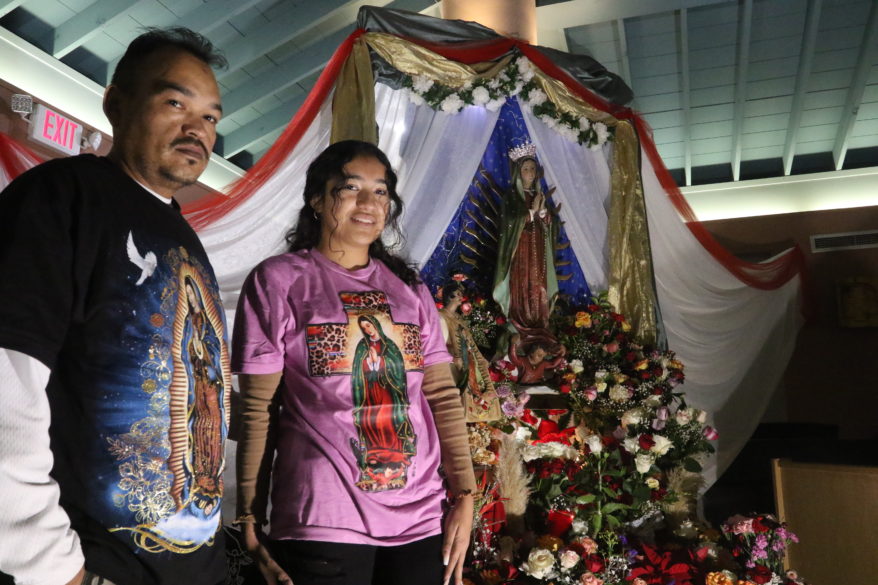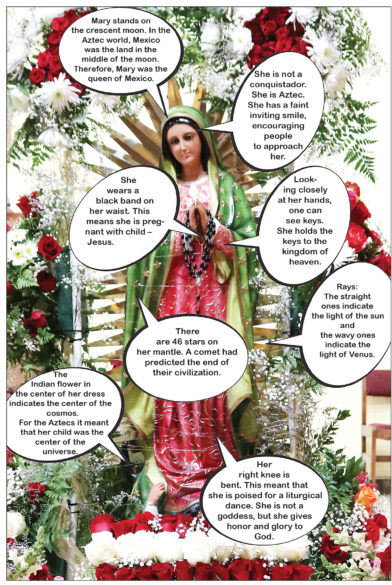By Galen Holley
NEW ALBANY – The soft, musical whispering of the rosary was interrupted only momentarily by the raucous, heartfelt shouting of “Vive!” as Hispanic parishioners at St. Francis of Assisi Catholic Church in New Albany welcomed the approaching dawn.

They prayed the Joyful Mysteries. The Holy Rosary is a blessing from the Virgin, and although all the mysteries depict episodes throughout the gospels, perhaps none more vibrantly unfold the feminine, motherly life of Mary as do the Joyful Mysteries.
The parishioners started at 4:30 a.m. Many had to be on factory furniture lines when the belt started rolling at 6 a.m. Still, they rose early, put on at least one special article of clothing, and found a spot in the crowded little church to kneel and pray.
Alejandro Caballero and his friend, Maria, donned matching shirts bearing the image of the Virgin. Their garments were bedecked with sequins and many handmade, special attentions.
Many of the faithful, like Bernie Garcia and family, whose patriarch, Pablo, is studying to be a deacon, brought in cooing babies in bassinets. Others walked arm-in-arm with aging abuelos, wrapped in shawls against the damp, morning air. “Ave, Maria,” they all whispered, crossing themselves with holy water and never turning their backs on the Blessed Sacrament.
Mary, the mother of Jesus, has been depicted in many ways, most often as a blushing, pale European. Our Lady of Guadalupe is an ethnic image of Mary, one with dark, distinctly indigenous features who exemplifies the universality of the Christian Gospel.


In the Guadalupe apparition, Mary had dark skin and spoke in Nahautl. Her turquoise cloak signaled royalty to the indigenous people; the black sash around her waist was their sign for pregnancy. She was clothed in stars and stood upon the moon – signs connecting her both to Indian concepts of deity and to Revelations 12:1.
Today, the image of “Nuestra Senora de Guadalupe” is perhaps the most pervasive religious image in Hispanic culture.
St. Francis of Assisi Parish demonstrates to the surrounding community how the Christian Gospel reaches across racial, ethnic and cultural divides. Father Jesu Raj Xavier, a native of India, speaks excellent English, and he’s quickly learning Spanish. Pablo Garcia has long been a leader in the Hispanic community, and now he’s making a focused effort to improve his English. Anglo and Hispanic parishioners feel equally at home at both Sunday morning masses.
Juan Diego, the native man to whom the Virgin appeared, was canonized as a saint in the Roman Catholic Church in 2002. His cloak, bearing Mary’s image, hangs in the Basilica of Our Lady of Guadalupe near Mexico City on the site of the Tepeyac Hill. The basilica is one of the most visited sites in Christianity, second only to the Vatican in number of annual pilgrims.
Southern culture is one in which mothers’ welcome children and their friends to the table. The abundance of life and nourishment found in the Gospels is the bread that feeds us all. The motherly love of Our Lady of Guadalupe, which the parishioners at St. Francis of Assisi demonstrate so well, is a symbol of the life available to all of us through the sacraments and in loving union with one another.
(Galen Holley is a parishioner of St. Francis in New Albany.)
More picture around diocese:
Pearl, Jackson Cathedral, Jackson St. Therese, Madison and Tupelo
Symbols in the image of Our Lady of Guadalupe
By Msgr. Michael Flannery
In the world of the Aztec Indian, they examined the signs and symbols and related these to each other, so that the hieroglyphics told the whole story when put together. Different explanations are found, but all of them are variations of the same theme.
- Mary is standing on the crescent moon. In the Aztec world, Mexico was the land in the middle of the moon. Therefore, Mary was the queen of Mexico.
- The moon is black moon. This meant that Mary would overcome falsehood and lead to truth.
- Her right knee is bent. This meant that she is poised for a liturgical dance. She is not a goddess, but she gives honor and glory to God.
- Time of the apparition. It was early in the morning. This would mean the first manifestation of God.
- There are clouds in the extremities of the picture. Clouds signified the presence of God.
- The rays: Their form is elliptic, small at the ends and bigger closer to the source. The straight ones indicate the light of the sun and the wavy ones indicate the light of Venus.
- Mary is standing in front of the sun and Venus. This indicated that she was greater than the sun and Venus. The sun and Venus were two of their important deities in the Aztec world. She was not going to take them away from the Aztecs.
- She wears a blue mantle. This is a royal color, but she is not a god. There are 46 stars on her mantle. A comet had predicted the end of their civilization. Now stars indicate a new beginning. In recent times astronomers have found that that was the exact location of the stars on December 12, 1531.
- She wears a black band on her waist. This means she is pregnant with child.
- She has a broch with a cross. She is pregnant with child and the child is Jesus.
- Her face and color. She is not a conquistador. She is Aztec. She has a faint inviting smile, encouraging people to approach her.
- Her eyes are gentle and soft.
- Her hair is combed in the style of the Aztec Indian. Another indication that she has not come with the conquistadores.
- Her hands. A close look at her hands and one can see keys. She holds the keys to the kingdom of heaven.
- The angel. She is supported by an angel. The angel has dark eyebrows. He is a mature angel and the message of the lady is believable.
- The angel holds her tunic in one hand and her mantle in the other. For the Aztec this meant that she joins heaven and earth together.
- She spoke Nahuatl to Juan Diego. This was the language of the Aztecs. It reverses the roles. It is the conquered now telling the conqueror what to do in building a temple for Our Lady.
- Flowers and music were the best ways to communicate with the gods and both flowers and music are used as the drama unfolds.
- Her dress. It is a pale red. The color of the rising sun. It indicated new life is coming.
- The Indian flower: Right in the center of her dress is the Indian flower. This indicated the center of the cosmos. For the Aztec it meant that her child was the center of the universe. This was the new temple of the presence of God and it was in her womb.
- The inverted J. The inverted J on the right side of her dress signified the light of the world in the Aztec culture.
For the Aztec standing before the picture of Our Lady of Guadalupe, it told the whole story. No further explanation was needed. They understood perfectly what Our Lady wanted to communicate to them. Ten years following the apparition, the number of converts to Christianity had grown from 10,000 to 10 million and all because of the picture. It happened mostly by word of mouth. The good news was spread by the Aztecs themselves.
There has always been a tremendous devotion to Our Lady of Guadalupe. She is the patroness of the Americas. Ten million people visit her shine every year. Mexico had a number of persecutions against the Catholic church in its history. Nevertheless, they have never been successful in closing the Basilica of Our Lady of Guadalupe. In a persecution which took place in 1921, a bomb was placed beneath the image of Our Lady of Guadalupe. The bomb exploded. A bronze crucifix nearby was seriously damaged, but no damage was done to the image.
Overtime, studies of the tilma (poncho) have been made. The conclusions were that it was made from the Maguey plant. It is a coarse fiber and does not take well to paint. In another study, done by Kodak, it was found that the image was imprinted on the tilma and not painted. The most noted study took place in 1951 when an ophthalmologist, Dr. Enrique Grave y Diaz Gonzalez sought and received from the archbishop of Mexico City, permission to do a detailed study of the eyes of Our Lady. There on the retinue of the eyes, in miniature, is the reflection of the Archbishop, his secretary, and an image of an Indian woman sitting in the background. An artist would not have been able to paint this in the detail that is there and in its miniature form.
Our Lady of Guadalupe, pray for us!
